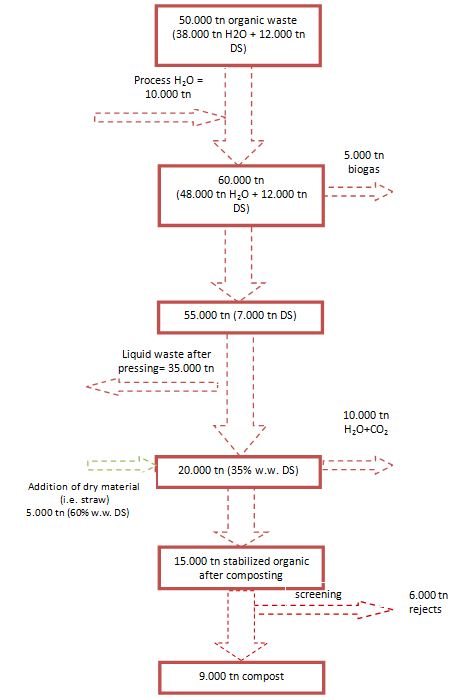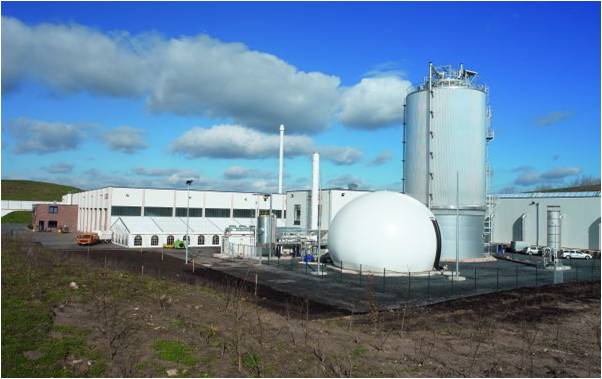 |
Database of Waste Management Technologies |
 |
AD 1: Dry AD followed by open air windrow composting
“Dry” AD technology
“Dry” AD processes are used to treat dry materials (c.80% moisture) ranging from thick slurry to a wet solid and use plug flow reactor designs. This approach involves adding fresh waste and/or partially fermented waste into one end of the reactor while fully digested residue is extracted from the other. Dry technologies can comprise vertical or horizontal tanks. Vertical tanks rely on gravity to move material through the system, whereas horizontal systems use specialised augers or baffles. A potential advantage of the dry system is that it can tolerate higher levels of physical contaminants.
AD technologies can be operated at moderate (mesophilic: 30 – 40°C) temperatures or high (thermophilic: 50 – 60°C) temperatures. ‘Dry’ AD processes lend themselves to thermophilic operation due to higher solids content and greater biological heat production.
AD processes can be single step processes where all the waste is placed into a single digestion stage/vessel, or a multiple step process using vessels to optimise different stages of the process. Multiple step processes often involve a separate hydrolysis stage, which can be aerobic or anaerobic, to breakdown complex organic material into soluble compounds. This is followed by a high-rate biogas production stage. It is common for dry AD systems to operate as a “single step” process.
Biogas produced during anaerobic digestion is primarily composed of methane (typically ranging between 50 – 75%) and carbon dioxide, as well as smaller quantities of other gases including hydrogen sulphide. Biogas is also water saturated (100% humidity).
The amount of biogas produced using AD will vary depending on the process design, such as retention times and operation temperature, and the volatile solids (organic matter) content of the feedstock, i.e. the composition of the waste inputs.
Biogas is stored in large vessels prior to its use on or off site. Biogas can be used in a number of ways. It can be used as a natural gas substitute (distributed into the natural gas supply) or converted into fuel for use in vehicles. More commonly it is used to fuel boilers to produce heat (hot water and steam), or to fuel generators in combined heat and power (CHP) applications to generate electricity, as well as heat.
Biogas electricity production per tonne of waste can range from 75 to 225 kWh, varying according to the feedstock composition, biogas production rates and electrical generation equipment. Generating electricity from biogas is considered ‘renewable energy’ and benefits from support under the Renewables Directive.
In most simple energy production applications, only a little biogas pretreatment is required. Biogas used in a boiler requires minimal treatment and compression, as boilers are much less sensitive to hydrogen sulphide and moisture levels, and can operate at a much lower input gas pressure.
Where biogas is used for onsite electricity generation, a generator similar to that used in landfill gas applications can be used, as these generators are designed to combust moist gas containing some hydrogen sulphide. Gas compression equipment may be required to boost the gas pressure to the level required by the generator.
Some electricity is used by the AD plant, but excess electricity produced (typically ~75%) can be sold and exported via the local electricity distribution network. Excess heat can also be used locally in a district heating scheme, if there is an available user.
For high specification applications (e.g. vehicle fuel, natural gas substitute), or when using more sophisticated electricity generation equipment (e.g. turbines), biogas will require more pre-treatment to upgrade its quality. This includes the removal of hydrogen sulphide (a corrosive gas); moisture removal; pressurization to boost gas pressure; and removing carbon dioxide to increase the calorific value of the biogas. However, the cost of the equipment required to upgrade biogas can be prohibitive.
Organic matter leaving the digester forms a sludge-like material due to the high moisture content of the waste material entering the process and the breakdown of solids during digestion. The material produced is kept in a storage tank and can be mechanically pressed into its solids (digestate) and liquid (liquor) fractions.
The dewatered digestate may be used directly on land as a soil amendment provided it meets appropriate regulatory standards, or aerobically treated to produce a compost (if from source segregated material) or a compost-like output (if from mechanically separated material).
Some liquor may be recycled in the AD process to wet incoming waste; used directly on land as a liquid fertilizer due to its valuable nitrogen content (provided it meets appropriate regulatory criteria); or used to maintain moisture during the aerobic treatment of the digestate. Alternatively, if no other route is available, the liquor may be treated and discharged in accordance with permit requirements.
AD 1: Dry AD followed by open air windrow composting
This system incorporates Dry AD as described above, while the produced solid fraction (dewatered digestate) undergoes a further stabilisation step (composting). The composting system uses the “open air windrow” composting process (Composting 1). It should be noted that in this case, shredding in not a necessary preparation step, prior to composting.
Process Mass Flow Diagram

Process Photo

Process Operational Data
Area
An anaerobic digestion facility must be accommodated in a sufficient space for digester and power unit installation. Some additional space for refining and storage is also necessary, while traffic and turning areas, a buffer zone for landscaping, wastewater treatment infrastructure and a small office must also be taken into account. According to data from various existing facilities (HYDER CONSULTING, 2007; ARI et al. 2008; RIS et al. 2005) land requirements range from 0.15 to 0.40 m2 per tonne of feedstock per year.
Energy
Unlike composting plant, AD facilities can potentially utilise some of the energy generated within the process to meet their requirements. According to data from various existing facilities (HYDER CONSULTING, 2007; ARI et al. 2008; RIS et al. 2005) electricity consumption of facilities ranges from 30 kWh to 68 kWh per tonne of organic waste feedstock, while IPPC BREF for Waste Treatment Industries (European Commission, 2006a) reports 50-55 kWh per ton of organic waste treated.
Regarding the heat requirements of the AD process, IPPC BREF suggests that up to one third of the biogas produced is needed to heat the digester itself. The significant heat requirement is confirmed by data provided from plants in Germany and the UK. Data from Bavaria suggests that a maximum two thirds of the heat produced by agricultural biogas plants can be used in some way under practical operating conditions, suggesting a heat requirement of 125 kWh per ton of input. Mass balance information provided by the UK operator Greenfinch suggests that up to 50% of the heat may be required (equivalent to 216 kWh of heat per ton of input) although 130 kWh is more typical. Arcadis et al. (2010) assumes that the AD process utilizes 30 kWh of electricity and 118 kWh of heat per ton of input to the process, equivalent to 10% of electricity generated, and 33% of the heat generation.
These energy requirements are supplied by the AD process itself with energy exploitation of biogas produced. The amount of produced biogas, which methane content is 55-65%, depends on the composition of feedstock. Comparatively little information is available on the amount of biogas produced by different feedstocks in an anaerobic digester. The only pure research is from bench-scale studies carried for the USEPA, where the relative contributions of different materials to landfill gas generation (through anaerobic digestion) were measured. Results of this work, according to RIS et al. (2005), are presented in the following table.
| Material | Moisture (% wt) | Biogas Yield m3/kg of material feed* |
|---|---|---|
| Paper | ||
| Newspaper | 10 | 0.061 |
| Cardboard/Boxboard | 10 | 0.125 |
| Telephone Directories | 10 | 0.061 |
| Office paper | 10 | 0.178 |
| Mixed paper | 10 | 0.112 |
| Kitchen Waste | ||
| Food | 70 | 0.113 |
| Yard waste | ||
| Grass | 60 | 0.034 |
| Leaves | 0.023 | |
| Brush | 40 | 0.067 |
| Other organic | 0.101 |
According to data from various existing facilities (HYDER CONSULTING, 2007; ARI et al. 2008; RIS et al. 2005) biogas production ranges from 50 m3 to 150 m3 per ton of feedstock, with the lower values being characteristics of systems with shorter retention time.
Water
The amount of water added in the digester in dry systems is less than in "wet" systems (two to seven times). For some plants, some of the water from the dewatering process goes back to plant, while other facilities recirculate liquid from the digester either within the digester or reuse it as process water (RIS et al. 2005). According to IPPC BREF (European Commission, 2006) the total fresh water consumption for treatment of 1 tonne of organic waste is 78 kg, while HYDER CONSULTING (2007) reports 185 kg per ton of input to digester.
Process Environmental Indices
Air Emissions
This process is enclosed and air emissions are unlikely to occur except during transfer to and from the digester. Anaerobic systems generate less emission than aerobic systems per kilogram of waste, since the principal gaseous emission (methane) is a desired product. However emissions related to the delivery of waste and mechanical treatment may cause emissions of odours and dust and the anaerobic digestion of the digestate may cause a significant odour problem if not properly treated. Fugitive emissions of biogas are also possible from emergency vent valves and from poorly sealed water traps.
CO2 emitted from AD is not fossil-derived, and therefore, it is not considered as a greenhouse gas emission. According to IPPC BREF (European Commission, 2006a) fugitive emissions of CH4 are less than 1% of the total CH4 content of the biogas, ranging from 0 to 411 g per tonne of organic waste treated, while N2O emissions are assumed minimal.
The emissions generated by the combustion of the biogas are higher than the emissions generated during the biogas production process and they are presented in the following table (European Commission, 2006a).
| Pollutant | g/tonne |
|---|---|
| CO | 72.3 |
| NOx | 10-72.3 |
| SOx | 2.5-30 |
| VOC | 0.0023 |
| Dioxins/furans | (0.4 – 4) x 10-8 |
| Cd | 9.4 x 10-7 |
| Cr | 1.1 x 10-7 |
| Hg | 6.9 x 10-7 |
| Pb | 8.5 x 10-7 |
| Zn | 1.3 x 10-7 |
Wastewater
According to IPPC BREF for Waste Treatment Industries (European Commission 2006) the volume of generated wastewater is 0.47 m3 per tonne of organic waste treated, while HYDER CONSULTING (2007) reports 0.52 tn per ton of input to digester and Economopoulos (2007) reports 0.437 tn per ton of organic feedstock.
Residual
Residue consists of non-recyclable inerts which are not digestable, e.g., portion of glass, concrete, asphalt and ash, rock, textiles etc., which are removed during feedstock pre-process and compost refining processes. According to data from existing facilities residual is up to 0.12 tons per ton of feedstock.